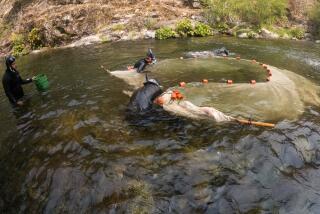Sweden’s War on Polluters of Lakes and Rivers Is a Net Gain for Salmon Fishermen
- Share via
STOCKHOLM — As part of a successful campaign to clean up lakes and rivers, Swedish authorities are making water polluters replace the fish they kill.
Because of the program, anglers and commercial fishermen now are catching about 70 tons of salmon a year from Lake Vanern, which was so polluted in the late 1960s that bait died on the hook.
During the last century, about 200 tons a year were taken from the lake. But in the postwar industrial boom, salmon catches slipped steadily with the expansion of hydroelectric power plants and increasing discharges of wastes, primarily mercury. Authorities said the program seeks to match the salmon yields of the last century.
The Uddeholm Co., a major offender, is under court order to supply 60,000 smolts, or young salmon, a year for an indefinite period because of damage caused by its hydroelectric plants on a river draining into the lake.
Smolts Donated
Its chemical division was ordered earlier to make a one-time donation of 200,000 smolts because of damage caused by its discharge of mercury in the lake.
There also are a number of cases pending against other hydroelectric plant owners for damage caused on rivers draining in to the lake, Europe’s third largest.
To meet its quota, Uddeholm has its own hatchery. Other violators buy their smolts from cultivation plants.
Fishery experts and local administrators have journeyed twice to the United States to study the restoration of Lake Michigan, which is regarded in Sweden as the most successful effort ever on a large polluted body of water.
Swedes are also focusing on the follow-up project to clean up Lake Ontario. Lesley Wedge, a fishery biologist in the Lake Ontario program, was invited to Sweden to survey the Vanern program, called the Salmon Fund.
‘Sitting on a Gold Mine’
“You are sitting on a gold mine,” Wedge told his hosts after a 10-day stay in September. He works at the Department of Environmental Conservation in Cortland, N.Y.
The sponsors of the Swedish project are the three provinces surrounding the 2,234-square-mile lake, which is one-third the size of Lake Ontario.
They have hopes of making it a tourist-fishing attraction.
In some ways, the Vanern cleanup is ahead of its Michigan and Ontario counterparts. Anglers at the American lakes, particularly Lake Michigan, are advised not to eat their fish too often because they hold unsafe levels of chemicals pollutants.
There are no longer such problems in Vanern, which was described as a giant sewer 15 years ago.
Tage Ros, the Vanern fishery superintendent and architect of the project, plans to plant about 500,000 smolts a year indefinitely until the annual catch of 200 tons has been attained.
Decision Due in Spring
A final decision on the program is to be made in the spring and the project is expected to be in full swing by 1989.
“If we can move according to plan, we would most likely attain the goal in early 1990,” said Ros, who is credited with saving the Gullspang salmon from extinction.
That salmon, one of the fastest-growing of its kind, was landlocked in Vanern 7,000 years ago, and can grow an average of nearly nine pounds a year.
Project head Lars Breiling said Swedish biologists visiting the United States studied seeding and cultivation of smolts, means to supervise fishing and a number of spinoff industries during their stay.
“They are both success stories,” he said of two Great Lakes.
“We’ve learned a great deal. Also we learned from their mistakes so we don’t have to duplicate them.”
Authorities here were lukewarm about renewal projects until a record low catch in 1971 jolted wildlife and fishing officialdom.
Now, the Vanern project is part of a national plan.
More to Read
Sign up for Essential California
The most important California stories and recommendations in your inbox every morning.
You may occasionally receive promotional content from the Los Angeles Times.













